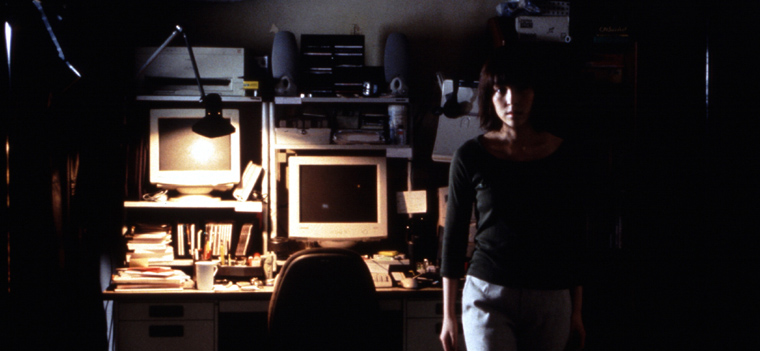
Pulse
Studio: Magnolia Pictures
Written and directed by: Kiyoshi Kurosawa; Starring: Haruhiko Kato, Kumiko Aso, Koyuki and Kurume Arisaka
Nov 12, 2005
Web Exclusive
![]()
Some of the best horror films are born out of prevailing social issues of the day and, like most films of the genre, capitalize on fears that linger at the very core of our being. George A. Romero’s Night of the Living Dead has been interpreted to contain strong criticism of U.S. foreign policy in the 1960s, but its zombies embody both the terror of our mortality and our fascination with immortality, just as Jaws plays to our fear of the deep orHalloween personifies the boogeyman. Kiyoshi Kurosawa’s Pulse finds its roots in Japan’s ongoing problems with over-population and, using the Internet as a means, sets out to make simple but potent commentary on our perchance for seclusion and the quiet, desperate loneliness that can result.
Released overseas in 2001, Pulse finally is getting U.S. distribution from Magnolia Pictures. Miramax originally purchased the film with the intention of re-making it into an American version, a la The Ring and Dark Water. It took some time, but that version will be released in the springtime and will star Kristin Bell (Veronica Mars).
Kurosawa has been making films for over 25 years and received international acclaim in 1997 for his film,Cure, a thriller that brought favorable comparisons to David Fincher’s Seven. The former sociology student fashioned Pulse around some basic questions he had about the afterlife. In the press notes, Kurosawa asks, “What exactly are ghosts? Are ghosts humans who once were alive? Or are they merely the embodiment of death? And how would such ghosts choose to interact with humans living in the real world?”
Without giving away too much, Pulse centers on a small group of university students and young professionals who encounter a whole lot of strange activity on the Internet. This follows the mysterious suicide of a co-worker who, at the time of his death, was in possession of a disk that might have led to his fate. Clues to his inexplicable disappearance are scarce until one of the students keenly suggests that the parallel universe housing the dead is over-booked. What he doesn’t say, though it’s implied, is that the dead are not content on merely moving into our world—hence the escalating body count.
The beauty of Pulse is not so much what it does, but what it doesn’t. Sometimes the most frightening sound is no sound at all, and Kurosawa knows this. A few cello lines can be equally unnerving. (It’s unfortunate that so many Hollywood horror films fail to utilize score the way Kurosawa does.) Pulse also features some of the most terrifying images imaginable, and you may not believe it, but this would include the sight of an ordinary-looking woman “walking” toward the camera. Context here is everything. Oh, and there’s no blood—not a single drop.
Sure, Pulse falls prey to some clichés—ones that elicit the familiar don’t-go-in-there! from an audience—but even here they seem somewhat self-aware; you can’t help but sense a wink from the director as a gas cap rolls into a room housing certain doom. But perhaps the biggest triumph of Pulse is that in the end, the implications of the film are far more disturbing than any single horrific image it can conjure. To think life could be wasted away in solitary pursuits, thrown away before it’s even over, is beyond depressing.
Pulse (www.pulsefilm.net) begins a one-week engagement at Landmark’s Nuart Theatre in Los Angeles on November 18.
Author rating: 6/10
Average reader rating: 5/10
Current Issue

Issue #72
Apr 19, 2024 Issue #72 - The ‘90s Issue with The Cardigans and Thurston Moore
Most Recent
- Under the Radar Announces The ’90s Issue with The Cardigans and Thurston Moore on the Covers (News) — The Cardigans, Thurston Moore, Sonic Youth, Garbage, The Cranberries, Pavement, Lisa Loeb, Supergrass, Spiritualized, Lush, Miki Berenyi, Miki Berenyi Trio, Emma Anderson, Hatchie, Ride, Slowdive, Velocity Girl, Penelope Spheeris, Terry Gilliam, Gus Van Sant, Ron Underwood, Kula Shaker, Salad, Foals, Semisonic, The Boo Radleys, Stereo MC’s, Pale Saints, Blonde Redhead, Sleater-Kinney, Cocteau Twins, Lucy Dacus, Alex Lahey, Horsegirl, Grandaddy, alt-J, Squid, The Natvral, Wolf Alice, Jess Williamson, Sunflower Bean, Orville Peck, Joel McHale
- The Tortured Poets Department (Review) — Taylor Swift
- 10 Best Songs of the Week: Fontaines D.C., Cassandra Jenkins, Loma, John Grant, and More (News) — Songs of the Week, Fontaines D.C., Cassandra Jenkins, Loma, John Grant, Good Looks, Hana Vu, Belle and Sebastian, Yannis & The Yaw, Strand of Oaks, Home Counties
- Fresh Shares New EP ‘Merch Girl’ (News) — Fresh
- Premiere: LOVECOLOR Shares New Video for “Crazy Love” (News) — LOVECOLOR

Comments
Submit your comment
There are no comments for this entry yet.